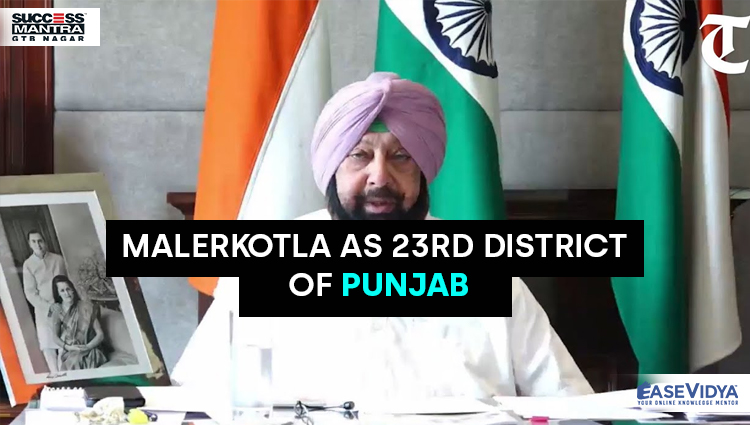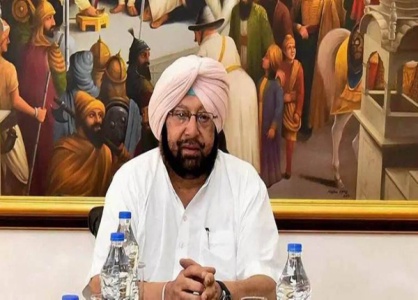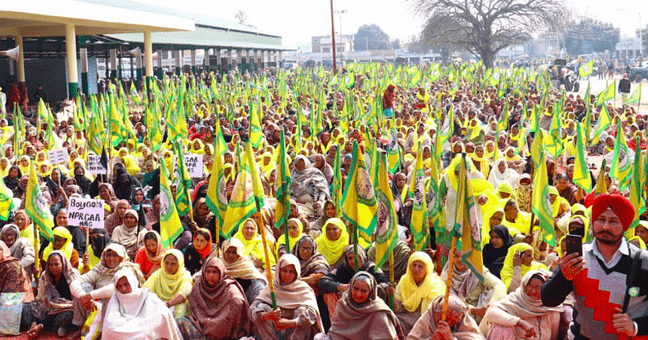
MALERKOTLA AS 23RD DISTRICT OF PUNJAB
MALERKOTLA AS 23RD DISTRICT OF PUNJAB

Recently, the Punjab government has announced the formation of Malerkotla as the 23rd district of the state. Section 5 of the Punjab Land Revenue Act, 1887 says the “State government may, by notification, vary the limits and alter the numbers of tehsils, districts and divisions into which the State is divided.”
History of Malerkotla: The Malerkoltla is former princley state and only Muslim-dominated town of Punjab. Historically, Malerkotla owes its foundations in the 15th century to Sufi saint Sheikh Sadrauddin Sadar-i-Jahan, also known as Haider Sheikh. After the decline of the Mughal empire, Malerkotla’s rulers exercised greater independence and at the time of the invasion of India by Ahmad Shah Abdali from Afghanistan, they aligned with him. Ahmed Shah Abdali invaded India eight times from 1748 to 1767. In 19th century, Malerkotla became one among the cis-Sutlej states. Malerkotla continued under the British protection and the alliance with the neighbouring Sikh states till 1947 when it became the only Muslim majority Sikh state in East Punjab. After the dissolution of the princely states in 1948, Malerkotla joined the new state of PEPSU or Patiala and East Punjab States Union (PEPSU). PEPSU itself was dissolved in 1954 and Malerkotla became a part of Punjab.
CIS-SUTLEJ STATES
The Cis-Sutlej states were a group of small states in Punjab region in the 19th century, lying between the Sutlej River on the north, the Himalayas on the east, the Yamuna River and Delhi District on the south, and Sirsa District on the west. The states were called Cis- Sutlej by the British because they were on the British, or southern, side of the Sutlej River. The Cis-Sutlej states included Kaithal, Patiala, Jind, Thanesar, Malerkotla and Faridkot. Under the threat of absorption into Sikh Maharaja Ranjit Singh’s kingdom, they appealed to the British, who established dominance over them by the Treaty of Amritsar with Ranjit Singh (1809). The states survived until the independence of India (1947), at which time they were organized into the Patiala and East Punjab States Union (PEPSU). They subsequently were absorbed into the Indian states of Punjab and Haryana.
MALERKOTLA & THE SIKH COMMUNITY

‘Haa Da Naara’ Episode (1705): Malerkotla Nawab Sher Mohammad Khan had raised his voice (‘Haa Da Naara’) against brutal execution of Chote Sahibzade (youngest sons of Guru Gobind Singh — Zorawar Singh (9) and Fateh Singh (6) – by Nawab of Sirhind, Wazir Khan in 1705. Gurdwara Haa da Naara Sahib was built in Malerkotla to commemorate the voice raised by Sher Mohammad Khan.
Wadda Ghallugara (1762): The Nawab Bhikam Shah fought on the side of Abdali’s forces in a battle against the Sikhs in 1762. The battle is known as ‘Wadda Ghallugara’ or the Great Holocaust where tens and thousands of Sikhs were killed.
Treaty of Friendship (1769): In 1769, a treaty of friendship was signed with Raja Amar Singh of Patiala by the then Nawab of Malerkotla.
Namdhari Massacre (1872): The British administration of Malerkotla (Punjab) was attacked by the contingents of Namdharis (a sect of Sikhs) under the leadership of Hira Singh and lehna Singh, on 15th January, 1872. The British Administration ordered that the Namdhari revolutionaries should be brought to the Parade Ground and blown up with cannons. That ground as a symbol of martyrdom has been named now as ‘Kukian Da Shaheedi Park’.
CREATION OF NEW DISTRICTS
Role of State: The power to create new districts or alter or abolish existing districts rests with the State governments. This can either be done through an executive order or by passing a law in the State Assembly. Many States prefer the executive route by simply issuing a notification in the official gazette.
Purpose of Creation: States argue that smaller districts lead to better administration and governance. For example, in 2016, the Assam government issued a notification to upgrade the Majuli sub-division to Majuli district for “administrative expediency”.
Role of Centre: The Centre has no role to play in the alteration of districts or creation of new ones. States are free to decide.
Role of Home Ministry: The Home Ministry comes into the picture when a State wants to change the name of a district or a railway station. The State government’s request is sent to other departments and agencies such as the Ministry of Earth Sciences, Intelligence Bureau, Department of Posts, Geographical Survey of India Sciences and the Railway Ministry seeking clearance. A no-objection certificate may be issued after examining their replies.
Number of Districts in India: According to the 2011 Census, there were 593 districts in the country. Between 2001-2011, as many as 46 districts were created by States. Though the 2021 Census is yet to happen, currently there are 718 districts in the country. The surge in number is also due to bifurcation of Andhra Pradesh into A.P and Telangana in 2014.
TEST YOURSELF
Q.1 Recently, which of the following districts have been announced by the Punjab government as the 23rd district of the state?
- Fatehgarh Sahib
- Malerkotla: ANSWER
- Barnala
- None of the above
Q.2 Consider the following statements & state which of the following is incorrect in the reference of the above mentioned passage?
- Section 8 of the Punjab District Creation Act, 1887 says the “State government may, by notification, vary the limits and alter the numbers of tehsils, districts and divisions into which the State is divided.”
- The Cis-Sutlej states were a group of small states in Punjab region in the 19th century, lying between the Sutlej River on the north, the Himalayas on the east, the Yamuna River and Delhi District on the south, and Sirsa District on the west.
- Only I follows: ANSWER
- Only II follows
- Both I & II follows
- None of the above
Q.3 Which of the following given statements is/are incorrect in the reference to the creation & alteration of new districts in the states?
- This can either be done through an executive order or by passing a law in the State Assembly. The Centre has no role to play in the alteration of districts or creation of new ones.
- The power to create new districts or alter or abolish existing districts rests with both the Centre & State governments: ANSWER
- None of the above
Q.4 The State has to ask which of the following Union Ministry of the nation if the State wants to change the name of a district or a railway station?
- Housing & Urban Affairs Ministry
- Home Ministry of India: ANSWER
- Railway Ministry of India
- None of the above
Q.5 Which of the following Article says that the union is indestructible but the power conferred on Parliament includes the power to form a new state or union territory by uniting a part of any State or Union territory to other State or Union territory?
- Article 3
- Article 12
- Article 368: ANSWER
- Article 370












MikrozaimVor
Поговорим о чем-то важном: вы когда-нибудь чувствовали себя потерянным в мире финансов? На нашем сайте мы стараемся сделать все проще и понятнее. Мы знаем, как иногда бывает трудно выбрать, поэтому собрали всю нужную информацию в одном месте. Вот вы, например, знали, что можно получить займ с 18 лет без доказательства дохода? И есть столько способов получить деньги – на карту, электронный кошелек, наличными... Мы здесь, чтобы помочь вам сделать правильный выбор! Mikro-Zaim-Online - <a href=https://mikro-zaim-online.ru/>быстрый займ на карту без процентов онлайн</a> без проверки кредитной истории: как получить займ просто и быстро.